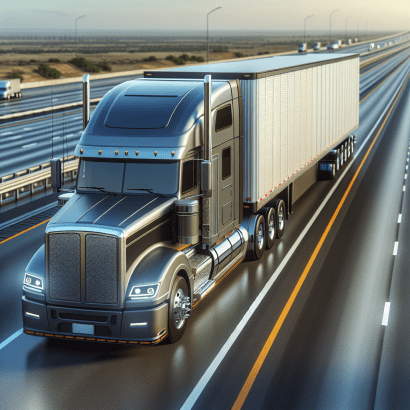
All biofuels have environmental advantages over fossil fuels, as they come from renewable sources. Advanced biofuels are even more beneficial, as they meet a higher emissions reduction benchmark and come from non-food feedstocks to avoid competing with food demands. While they may be less desirable than zero-emission alternatives, they could support decarbonization in construction and transportation in several ways.
Heavy-Duty Equipment Emissions Reductions
One of the most significant benefits of advanced biofuels in transport and construction is their viability in heavy-duty machinery. Such equipment is responsible for 25% of transportation emissions, making it a prime target for decarbonization. However, electrifying it is complicated.
Construction equipment and long-haul trucks require a substantial amount of power compared to consumer vehicles. They must also perform harder work for longer periods. Consequently, charging would be too frequent and take too long.
Technological advancements will eventually overcome these limitations. However, biofuel could reduce emissions in existing heavy equipment before those breakthroughs occur. That way, industrial operations could reduce their environmental impact before more substantial improvements become possible.
Buying Time for Infrastructure Expansion
Rather than waiting for zero-emission infrastructure to become more common, industry professionals can use advanced biofuels to reduce construction and transport emissions today. A lack of charging points is a significant barrier to consumer EV adoption and the electrification of long-haul trucks. Expanding infrastructure will take time, so a short-term solution is necessary.
The number of chargers is not the only concern. These endpoints must also become more robust to feasibly charge industrial-grade electric fleets. A station may need to produce as much as 20 megawatts of power to recharge multiple Class-8 trucks, requiring a substantial upgrade in charging technology. Those innovations will one day be possible, but biofuels can lower emissions before then.
Advanced biofuels are particularly advantageous in remote construction projects that rely on fossil fuel generators. As a drop-in fuel, biofuels could power diesel generators to reduce on-site emissions when charging would be impossible. Biofuel-powered generators could also provide electricity for smaller electric equipment for small decarbonization steps.
Keeping Sustainability Affordable
Many biodiesels can work in all diesel engines with no modifications. As a result, fleets and construction crews could use them to become more sustainable without expensive vehicle replacements.
Even when EVs can reasonably replace heavy-duty machinery, they’re often more expensive. The gap between fossil fuel and electric alternatives can be even more extreme with this equipment than in consumer markets, given the need for higher battery capacities. Consequently, driving costs down is key to encouraging sustainable industrial fleets.
While advanced biofuels may cost more than conventional diesel, they’re more accessible than replacing existing machines with electric alternatives. In addition to promoting faster adoption of low-emission solutions, those savings also leave room in company budgets for future investments in other environmental initiatives.
Providing Clean Backup Power
Advanced biofuels are a helpful alternative to renewables and electrification when power infrastructure fails. Blackouts are a fairly common issue. Intermittent renewables may be even more prone to service interruptions. Considering how outages cost U.S. businesses roughly $80 billion annually, backup solutions are essential. Biofuels can fill that role.
Diesel generators are already common on construction sites. They can operate on advanced biodiesel to provide backup power with lower emissions. When the power grid fails — rendering plug-in equipment offline — teams can use these tools to maintain productivity without releasing excessive greenhouse gases.
Keeping biofuel-powered equipment in case fully electric options malfunction or run out of charge has a similar effect. As fleets transition to EVs, they can retain older diesel models as backups in the event of such issues without the same emissions as conventional fuels.
Potential Challenges of Advanced Biofuels
As these use cases show, advanced biofuels can be a helpful way to reduce construction and transportation emissions before larger decarbonization steps become practical. However, they are not a perfect solution.
While advanced biofuels produce at least 50% lower emissions than fossil fuels, they still entail some greenhouse gases, if not from their fumes, then from their production. Consequently, their increased adoption may spur greenwashing fears. Some companies may embrace biodiesel to say they’ve gone green but never go further. In such a scenario, biofuels could delay the switch to full decarbonization.
Scaling up advanced biofuel production may also pose a challenge. It costs between 13 and 29 Euros to produce one gigajoule of waste-derived biofuels, compared to just eight to 14 Euros for fossil fuels. Non-waste biomass-derived fuels are even more expensive. The necessary equipment also requires a significant investment, making it difficult to expand biofuel manufacturing while keeping it cost-competitive with fossil fuels.
It’s also worth noting that the “advanced” part of “advanced biofuel” is a crucial distinction. First-generation biofuels still carry high emissions and can threaten the environment through the expansion of agriculture while competing with food. Second-generation and third-generation alternatives are more sustainable, but not every business may recognize this discrepancy.
Biofuels Have Potential as a Decarbonization Solution
While challenges remain, advanced biofuels hold promise as a step toward decarbonization in construction and transport. These fossil fuel alternatives may not be a complete solution, but they can pave the way for a smoother transition to net-zero emissions while more dramatic improvements become viable. Given the significant carbon footprints of construction and transportation, that potential demands attention.

